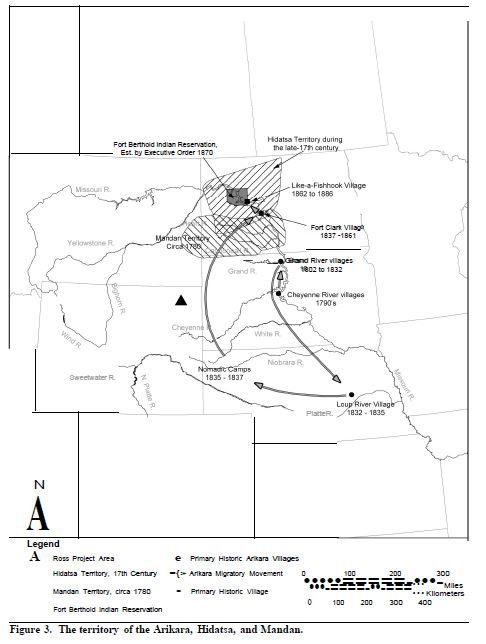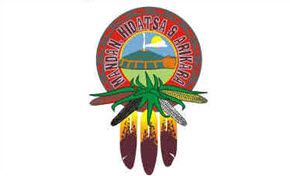The Arikara are the northern-most Caddoan-speaking tribe, whose language is thought to be a dialect of Pawnee (Parks 2001). However, while many early travelers noted the distinct linguistic similarities between the various tribes of the historic Arikara and the Pawnee, the two tribe’s languages are not mutually intelligible to modern speakers (Denig 1961; Parks 1979). Due to waves of smallpox epidemics and continuous conflict drastically reducing the Arikara population, by the late eighteenth and nineteenth centuries, each Arikara village had its own dialect. These dialects branched from two main groups, one closely resembling the Pawnee, and the other more closely resembling the modern Arikara language (Tabeau 1939). The Arikara refer to themselves as the Sahnish. Historically, the Arikara were also referred to as the Rees, particularly by French traders in the region (Denig 1961).
The Arikara are traced to the Upper Republican phase of the Central Plains Village Tradition (A.D. 1120-1250) located in Kansas and Nebraska. This cultural phase is generally characterized by maize horticulture, hunting, fishing and wild plant gathering; small semipermanent, unfortified villages, located on smaller tributaries near arable land, wood resources, or lithic sources with basic ceramics; and rectangular houses built below the ground surface (Wedel 2001). As the ancestral Arikara began to move northward and merged into the Plains Village Tradition (A.D. 1200-1400), they built large semi-permanent fortified villages of long rectangular houses that were located on high river terraces above the floodplain overlooking the main river channel (Wood 2001).
Later Ancestral Arikara moved further north, up the Missouri River into the modern Dakotas, and joined the Coalescent Village Tradition (A.D. 1300-1650) (Parks 2001). In this tradition, the Ancestral Arikara built villages somewhat larger than the previous period, but remained in the same geographic location and constructed villages as in previous periods. Their houses were dome-shaped, earthen structures with an interior wooden super-structure that was usually square, rectangular, or round. These homes were partially sub-surface, where the removed soil became part of the roofing material. The earliest periods of the phase were marked by somewhat smaller villages. Protohistorically, environmental and social conditions drew people into fewer, more densely populated villages with improved fortifications (Krause 2001). One major environmental factor included a warming trend that allowed corn to be grown more effectively in higher latitudes. The later periods of the phase saw the initial contact of displaced eastern woodland groups, such as the Sioux and Cheyenne, moving onto the Plains through the ancestral Arikara territory.
The earliest account of the Arikara was made by Etienne Bourgmont, who in 1714 was told of three Arikara villages on the west side of the Missouri River above the Niobrara River, along what is now the Nebraska-South Dakota border, and another 40 villages farther up the Missouri River (Parks 2001) (Figure 3). In 1719, the tribe was reported to be a 45-village segment of the Pawnee, and in 1723 they were reported to be living 10 leagues from the Omaha with whom they were allied (Parks 2001). In 1743, sons of the French explorer, La Verendry, visited an Arikara village and called them the “Little Cherry People.” This group was said to be living along the Missouri River at the mouth of the Bad River, in the modern location of Pierre, South Dakota.

At the end of eighteenth century, with the expansion of the fur trade out of Saint Louis, more accurate and detailed descriptions of the Arikara’s location began to be compiled. Most traders recorded small numbers of villages below the mouth of the Cheyenne River, north of modern- day Pierre, South Dakota (Parks 2001). Jean-Baptiste Truteau led a trade expedition up the Missouri River in 1795 and lived a year with the Arikara at the Cheyenne River villages. This was the tribe’s introduction into the fur trade and the first sustained contact with Europeans. Truteau noted that accounts from the tribe stated that the Arikara had numbered over 30 villages, but three smallpox outbreaks had forced the tribe to live in two large consolidated villages along the west bank of the Missouri River. While many Native American tribes suffered rapid population loss, Lowie notes (1954:12) that James Mooney of the Bureau of American Ethnology estimated the Arikara population to be at 3,800 people in 1780; that was reduced to 2,600 by 1804. Shortly afterward, Truteau left the Arikara as they abandoned the Cheyenne River villages in an effort to avoid an anticipated Sioux attack and moved north towards the Mandan (Parks 2001).
Another French explorer, Pierre-Antoine Tabeau, and the Lewis and Clark Expedition visited and lived among the Arikara between the years of 1803-1804 at the tribe’s new villages located at the mouth of the Grand River on the west bank of the Missouri River. Tabeau and the Lewis and Clark Expedition noted that the three Arikara villages they encountered there were the remnants of 10 to 18 smaller groups that had consolidated into larger villages. Denig noted that many abandoned villages, some of “very ancient date,” mounded and overgrown with vegetation, along the Missouri River; these he attributed to the Arikara. Two of these Grand River villages were occupied continuously until 1823 or 1824 when hostilities broke out between the Arikara and a fur trader party under the command of William Ashley, which ran aground at the Village when traveling the river. The conflict resulted in the deaths of 15 fur traders. The U.S. military responded by sending 275 soldiers and 750 Sioux and mountain man volunteers (Denig 1961). The soldiers shelled the villages for several days. After the barrage, soldiers were sent into the village to request that the Arikara make peace. The Arikara rejected the offer by shooting at the soldiers from holes dug through the walls of their homes. The army had intended to continue the shelling, but the tribe had slipped away under the cover of darkness and fled to several Mandan and Hidatsa villages further north along the Missouri River (Morgan 1964; Parks 2001). This event marked the beginning of the Arikara’s growing distrust of the whites and traders of the Missouri River.
Concurrent with the violent encounters between the Arikara and the U.S. military, trade relations between the Arikara and the Europeans began to deteriorate. At one time, the French traders and American explorers of the eighteenth and early nineteenth centuries had characterized the Arikara as friendly towards whites. As the fur trade expanded along the Missouri River, however, new trading posts were established and trade relations were initiated with distant tribes.
This pushed the Arikara out of their comfortable position as middlemen in the trade network. The encroachment of whites into the region began to threaten the Arikara, and relations between the tribe and many traders turned hostile. The attack on the Ashley fur traders further deteriorated the situation to the point that the Arikara gained a reputation as being treacherous and violent to whites. This reputation, however, was mostly the result of rumor and propaganda promoted by the fur trading companies to isolate the Arikara (Ewers 1961). In 1825, the tribe returned to the abandoned Grand River villages and signed a peace and friendship treaty with the U.S. government. The treaty forced the Arikara to recognize the government’s right to regulate trade relations with the tribe.
In 1832, in response to persistent violent encounters with the Sioux, continued harassment from the U.S. military, a crop failure brought on by drought, and a scarcity of bison, the Arikara again fled the Grand River villages and moved south to live with the Skiri Pawnee along the Loup River near modern-day Genoa, Nebraska (Thwaites 1904-1907). Eventually tensions grew between the Arikara and the Skiri Pawnee. When it was learned that U.S. troops had been dispatched to settle the discord between the two tribes, the Arikara quickly abandoned their villages. For two years the tribe lived as mobile hunters moving through eastern Wyoming and the western Dakotas, until resettling near Fort Clark along the Missouri River in North Dakota where the Mandan were living. Soon after their arrival, a smallpox epidemic broke out, killing half the Arikara population. The Mandan suffered even more losses and abandoned the village, moving north with the Hidatsa (Denig 1961). The Arikara stayed in the partially abandoned village, even rebuilding it after a fire destroyed the abandoned Mandan homes. The Arikara occupied the rebuilt village until Fort Clark was abandoned and destroyed in 1861 (Parks 2001). The Arikara also suffered from severe drought affecting their horticultural practices in the mid- 1830s, furher increasing tensions with the U.S. military and neighboring tribes. Contemporaries such as Dodge and Catlin reported that some Arikara families abandoned village life altogether, and were observed living a more mobile lifestyle in hide-covered tipis (Denig 1961).
After leaving Fort Clark, the Arikara moved to the large Mandan and Hidatsa village of Like-a- Fish-Hook and lived there for over two decades. This led to an increase in Sioux attacks and more contact with European settlers and the U.S. government. In an effort to offset their shrinking territories and conflicts with the Sioux, the Arikara, as well as the Hidatsa and Mandan, re-established their roles as middlemen in trade relations with European settlers for guns, horses, and other trade goods. The Arikara then traded these items with other Plains tribes for buffalo meat, hides, and wild vegetables (Parks 2001).
In 1866, an unratified treaty was agreed upon by the tribe and the U.S. government that established lands located near Fort Berthold as those held in reserve for the Mandan, Hidatsa, and the Arikara. In 1870, an executive order solidified the terms of the unratified treaty and officially established the Fort Berthold Reservation. In 1880, these lands were reduced from the original 7.8 million acres to 1.2 million acres (Parks 2001). The Arikara continued to live in the village of Like-a-Fish-Hook until the advent of the Dawes Act and land allotment period.
After leaving the Like-a-Fish-Hook village in the 1890s, the Arikara began to live in individual family land allotments around the village area and eventually moved onto the Fort Berthold Reservation. The flooding on the Missouri River with the construction of the Garrison Dam in 1953 forced many Arikara to move to the northeast portion of the reservation near the town of Whiteshield (Schneider 2001). Today, Arikara tribal members mainly occupy the eastern portion of the reservation. The tribe is a member of the Three Affiliated Tribes, which also includes the Mandan and Hidatsa.
The Arikara were horticulturalists, practicing extensive wild food gathering and hunting. Bison was an important food source to the Arikara, and the meat was highly sought after. Bison meat was taken in mass hunts seasonally, generally in the early winter. Denig (1961) also reported that the mass hunts involved the drowning of the bison as they fell through the thawing spring ice of the Missouri River, and then were dragged ashore by the villagers. Bison was also procured through individual hunts, and obtained through trade from mobile tribes. Other animals used for food included elk, deer, antelope, geese and rabbits. The tribe also gathered fish using willow pens baited with rotten meat. The tribe’s horticultural practices were conducted solely by the women, and included the raising of 11 varieties of corn, and several varieties of squash, beans, watermelon, sunflowers, and tobacco generally on small plots varying in size from one- half to three acres (Lowie 1954; 22). The Arikara observed two harvests, one in August when “green” corn was collected, and the second in late September or early October when the mature ears were gathered for winter storage. Lowie is quick to point out that the use of maize is often overstressed, and the Arikara suffered from the same agricultural obstacles as later Euro- American farmers, namely low precipitation and wild foragers such as birds or ravenous grass- hoppers. The subsistence needs of the Arikara were met by a wide variety of wild foods, gathered primarily by women, including chokecherries, buffalo berries, plums, sand cherries, grapes, gooseberries, raspberries, prairie turnips, and wild onions. As stated previously in this description, the Arikara were noted traders and kept relations with many groups even during periods of tension between the tribes. During good growing seasons the Arikara would trade bison meat and other wild foods for the surpluses of corn and other agriculturally grown foods. Later, when hostilities between the Sioux and the Arikara increased, this may have been the primary way the tribe received bison and other wild meats. Many mobile hunting tribes traded with the Arikara, most notably the Cheyenne, Arapaho, Kiowa and Kiowa-Apache, and several western bands of Sioux (including the Oglala, Saone, and the Yanktonai). These groups were attracted to the Arikara villages as a trade center due to their access to European goods and domesticated foods. Accounts of mobile tribes living just outside of an Arikara village and trading exclusively with them were not uncommon. If hunting was poor and visiting groups had nothing to trade, it was not uncommon for the Arikara to be compelled to trade with aggressive groups with the threat of violence and intimidation (Ewers 1961; Parks 2001).
The Arikara had an elaborate religious system that was separate from, but related to an equally elaborate shamanistic system. These two systems were overseen by the priests, who were concerned with the welfare of the tribe as a whole, and the doctors, who ministered to ill individuals. The Arikara believe in a supreme power known variously as the Chief Above (ne se nu tnacitakux), Our Father Above (ati Ax tnacitakUx), or the Great Holy One (se ni wa rUxtinIhu nU). This is an amorphous power that resided in the heavens and was the ultimate source of the world and everything in it (Parks 2001). He was a neutral force who would not directly take part in human affairs. The deity, Mother Corn, was the intermediary between the Great Holy One and the earth’s inhabitants. She provided guidance during the early emerging periods of human life and came to people’s aid in times of need. Both Denig and Tabeau describe blessing ceremonies revolving around corn planting and harvesting. Below these two deities was an all- encompassing power called awa haxu that inhabited all living things and inanimate objects. The Arikara recognized a distinction between heaven power and earth power. For example, moon and sun power was regarded as a different force than the power possessed by animals or rivers. All power could be used for good or evil depending on the user of the power (Parks 2001).
Many of the rituals involved in Arikara society revolved around giving thanks and the seasonal punctuations of planting and harvest, as well as with the procurement of animal hides and meat. The ceremonies followed a set ritual calendar that began with the corn planting ceremony. Rituals were performed for the worship of specific deities or for the marking of a specific calendar event. The Arikara were not known for their use of the Sun Dance and may have only practiced it for a brief time in the nineteenth century (Parks 2001; Curtis 1907).
Arikara rituals were performed by two distinct groups: the Shamans (na wi nAhcitawi u) and the Doctors (Kuna u). Shamans, or priests, were responsible for tribal welfare, rituals, and ceremonies of thanksgiving. Doctors were more concerned with the healing of the sick and the understanding of disease and curing. These two groups often worked together in joint rituals within a medicine lodge (Parks 2001). Shamans were responsible for the upkeep and protection of the tribe’s medicine bundles, which were given to the tribe at its origin by deities who taught them to grow corn and perform thanksgiving ceremonies. Each band had a medicine bundle specific to that band and its history. The shaman and bundle custodian positions were often inherited and required a large investment of time to learn. Doctors were medical practitioners who were divided into two groups: those who practiced within a specific society and those who were not a member of a society but possessed healing powers. All healers specialized in the healing of specific wounds, ailments, or diseases (Parks 2001). The Doctor societies would come together in late summer to participate in an extended ritual that lasted from 3 to 8 weeks. During this period the Doctors were devoted day and night to singing, dancing, and practicing their medicine. These rituals were held in secret during the day but held in public at night where they could display their powers as healers (Parks 2001).
An individual, such as a Doctor or even regular tribal member, could receive supernatural power in many ways. The most common method involved a vision quest. A solitary man would fast on a high hill or in a burial ground in search of helpful spirits. The man would cry or in some cases slash his legs and arms, cut off a finger, or some other form of self-mutilation that would attract the sympathy of a spirit. If the man was successful in his quest he would be empowered by a guardian animal. He could then create a medicine bundle based on his vision. An alternative method involved the purchase of power from someone who had received a vision. After the transaction the buyer would be instructed in the use and secrets of the power. This method was very expensive and required a great deal of wealth. The existence of both the vision quest and the ability to purchase supernatural power allowed medicine bundles and power to disseminate throughout the tribe without being restricted to the wealthier individuals (Parks 2001).
The Arikara were a fluid confederation of bands arranged around villages. Each village was headed by a chief and conceived of as an extended kin network, possessed its own distinct endogamous organization. The basic units of organization within the villages were extended families organized by matrilineal descent. Generally, these extended kin units were matrilocal, and consisted of 15-20 individuals who lived in a large, communal earth lodges. These families could practice sororal polygyny, in which the husband was allowed to marry a woman and later marry her younger sisters. At the time of marriage, a couple would most likely live with the woman’s family, although in some cases they might receive a home of their own. Very infrequently the new couple might live with the man’s family. Kinship was bilateral, meaning a child called his father’s brothers “Father” and his mother’s sisters “Mother.” Children of a mother’s sister or father’s brother were considered siblings (Parks 2001).
A family’s home, garden, and fields all were the property of the wife. The Arikara women built the family home and looked after its general upkeep. Men were responsible for hunting and defending the village and fields. The women were often the main negotiators during trade negotiations since their produce was often the most sought-after of items (Parks 2001).
The social organization of the Arikara was stratified into social groupings based on the wealth of its members, although these groups were quite fluid. The highest positions, those of chiefs and priests, were inherited, but generally ranks were not static and a commoner could strive to acquire a higher status through sacrificing to deities and personal achievement. The higher ranks did tend to practice endogamy, consistently marrying into their own rank, thereby keeping much of the wealth among the wealthy (Holder 1970).
A village chief was a political and social leader, his rank signified by the holding of the Sacred Bundle, the charter of the village that symbolized its political and economic function as well as serving as the center of religious life. The Chief, who was recognized as the descendant of the original bundle-holder, could make many decisions for the village, but the priests of the village were the only ones who knew the rituals and power of the bundle. This made much of the upper class the most important spiritual practitioners in the village. Since village bundles were passed down through families, the position of chief and shaman powers were hereditary. Just below the highest rank were the Doctors. A Doctor position was not necessarily hereditary, but the costs of acquiring knowledge and curative powers and the practice of rank endogamy often kept commoners out of the Doctor rank as well (Holder 1970; Parks 2001).
The Arikara had several secular societies for both men and women that crosscut village and rank organizations. The Men’s societies were both military and benevolent, were quite powerful in socio-political decisions, and often emphasized the age of members. The military societies vied for dominance in hunting and warring parties, and taking turns to serve as village protectors during such activities. Most societies had no prerequisites for membership and the membership was fairly fluid. One man could be a member of several societies at once if he wished. These societies were all responsible for a specific social aspect of the village. The societies all had their own emblem or icon, as well as distinctive costume and a unique musical instrument with unique songs and dances to accompany the instrument. These societies often organized themselves in battle and competed with one another during raids (Parks 2001).
While Parks (2001) notes that no women’s societies were recorded in the nineteenth century, three distinct groups were organized by at least the twentieth century, and had as their primary function activities that were seen as auxiliary to the men’s societies. One notable women’s society was the Goose Society, the membership of which was primarily older women who strove for exceptional gardens and advancement in all things related to horticulture (Lowie 1915; Parks 2001).
By the nineteenth century the general confederacy of villages had been codified into 12 recognized tribal bands for both secular political and ceremonial purposes. The villages were subsequently organized hierarchically into groups of three, each group associated with a specific cardinal direction. The chiefs were also subsequently reorganized with a single head chief from the Awahu Band and three sub chiefs, each overseeing the chiefs of individual villages.
The Arikara were known to live in tipis seasonally during the summer months while hunting bison. Because they were mobile for only a portion of the year, the Arikara also built elaborate and extensive villages with numerous semi-permanent features such as fortified stockades, partially subterranean homes, and cache pits. These villages were usually organized around a large central Medicine Lodge built in the center of the village (Parks 2001). These structures were often designed to hold 400 to 500 people at a time and were the center of their religious system (Parks 2001).
The Arikara were considered expert potters who made fairly elaborate ceramic vessels. During the Plains Village phase (A.D. 1200 to 1400) the Arikara practiced a paddle and anvil shaped pottery style, made mostly of local clay with incised or cord impressed decorations (Wood 2001). Later during the Coalescent Village Tradition (A.D. 1400 to 1650) new pottery types developed with more elaborate decorations that included more varieties of incising, inscribing, and painting. The Arikara were also accomplished craftsmen with glass and traded for European glass beads for re-firing to make their own beads. Corn was an important part of the Arikara diet, and wooden and stone mortars were a part of every household.
The Arikara are thought to have extended their hunting activities deep into the Plains prior to the smallpox epidemics of the late eighteenth century. After the smallpox epidemics, the Arikara consolidated their territorial range in the confluence of the Cheyenne and Missouri Rivers. Throughout the mid-1830s the Arikara traveled through eastern Wyoming and western South Dakota, living in semi-sedentary villages or in small bands of hunter gatherers before eventually being settled on the Fort Berthold Reservation, in the late nineteenth century. Together with the Hidatsa and the Mandan, the Arikara are part of the Three Affiliated Tribes, all of which reside on the Fort Berthold Reservation in North Dakota.
TRIBAL RESOURCES
Arikara Tribe

Three Affiliated Tribes
404 Frontage Road
New Town, ND 58763
701.627.4781

